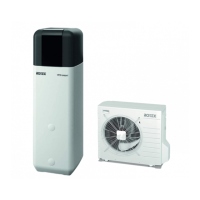2 x Safety
FA ROTEX HPSU compact 4 - 06/2015
7
2.5 Instructions for operating safety
2.5.1 Before working on the hydraulic system
Ɣ Work on the ROTEX HPSU compact (such as setup,
servicing, connection and initial start-up) is only to be carried
out by persons who are authorised and who have success-
fully completed qualifying technical or vocational training and
who
have taken part in advanced training sessions recog-
nised by the appropriate responsib
le authorities for the
specific activity. This, in particular, includes heating
specialists and climate control technicians who have
experience, as a result of their technical training and their
knowledge of the subject, of proper and appropriate instal-
lation and maintenance of heating, climate control and
cooli
ng installations and heat pumps.
Ɣ Switch o
ff the external main switch before starting any work
on the ROTEX HPSU compact and secure it against uninten-
tional switch-on.
Ɣ Seals
must not be damaged or removed.
Ɣ Make sure that the safety valves comply with the require-
ments of EN 12828 when connecting on the heating side, and
with th
e requirements of EN 12897 when connecting on the
domestic water side.
Ɣ Onl
y original ROTEX replacement parts may be used.
2.5.2 Electrical installation
Ɣ Electrical installation may be carried out only by electrical
engineers and in compliance with the valid electro-technical
guidelines as well as the regulations of the relevant energy
supply company (EVU).
Ɣ Compare
the mains voltage (~230 V, 50 Hz or ~400 V, 50 Hz)
indicated on the type plate with the supply voltage before
connecting to the mains.
Ɣ Before begi
nning work on live parts, disconnect all of the
systems circuits from the power supply (switch off main
switch, disconnect fuse) and secure against unintentional
restart.
Ɣ Equip
ment covers and service panels must be replaced as
soon as the work is completed.
2.5.3 Working on cooling systems (heat pump)
The ROTEX HPSU compact requires fluorinated greenhouse gas
for its function.
Ɣ Always wear safety goggles and protective gloves.
Ɣ When working on the refrigerant circuit, ensure that the
workplace is well ventilated.
Ɣ Never
carry out work on the refrigerant circuit in closed rooms
or work pits.
Ɣ Do not let coolant come into contact with open fire, embers or
hot objects.
Ɣ Never all
ow coolant to escape into the atmosphere (high
pressure at the point of the leak).
Ɣ Whe
n removing the service pipes from the filling connections,
never hold the connections in the direction of your body.
Residual refrigerant could escape.
Ɣ Components and spare parts must at least satisfy the
technical requirements defined by the manufacturer.
2.5.4 Site of installation
For safe and fault-free operation, it is necessary that the instal-
lation location of the ROTEX HPSU compact fulfils certain cri-
teria. Related information can be found in chapter 4.2.
Information on the installation site of other components can be
found in the associated documentation supplied with them.
2.5.5 Heating system and sanitary connection
Ɣ Create a heating system according to the safety requirements
of EN 12828.
Ɣ Wi
th sanitary connection, you must observe;
– EN 1717 - Protection of domestic water from contamina-
tion in domestic water installations and general require-
ments concerning safety equipment for the prevention of
do
mestic water contamination by back-flow
– EN 806 - Technical regulations for domestic water instal-
lations (TRWI)
– and, in addition, the country-specific legal regulations.
The connection of a solar installation, an electric heating rod or
an alternative heat generator may cause the storage temperature
to exceed 60 °C.
Ɣ F
or this reason you should fit scalding protection (e.g. VTA32
15 60 15 + Screw connection set 1" 15 60 16).
If the ROTEX HPSU compact is c
onnected to a heating system
with steel pipes, radiators or non-diffusion-proof floor heating
pipes, slurry and swarf could enter the hot water storage tank and
cause blockages, local overheating or corrosion.
Ɣ T
o prevent possible damage, fit a dirt filter or sludge
separator into the heating return flow of the system.
– SAS 1 ( 15 60 21)
2.5.6 Requirements for the heating water
To prevent corrosion products and deposits, observe the appli-
cable regulations of technology (VDI 2035, BDH/ZVSHK Tech-
nical information "Deposit Formation").
Minimum requirements regarding the quality of filling and sup-
plementary water:
– Water hardness (calcium and magn
esium, calculated as
calcium carbonate): 3 mmol/l
– Conductivity: 2
700 ȝS/cm
– Chloride: 250 mg/l
– Sulphate: 250
mg/l
– pH value (heating water): 6,5 - 8,5
Using filling water and top-up water whi
ch does not meet the
stated quality requirements can cause a considerably reduced
service life of the equipment. The responsibility for this lies solely
with the operator.
For work on stationary refrigeration systems (heat
pumps) and air conditioning systems, proof of expertise
is required in the European Community according to
the F-Gases Directive (EC) No. 303/2008.
– up to 3 kg coolant fill quantity: Expert certificate
ca
tegory II
– 3 kg coolant fill quantity or over: Exp
ert certifi-
cate category I

